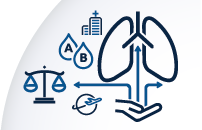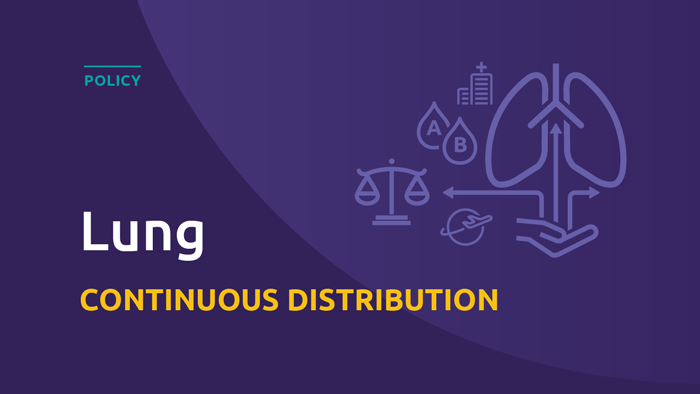Effective March 9, 2023, the Organ Procurement and Transplantation Network (OPTN) launched a new policy for matching lung transplant candidates with organs from deceased donors. It is projected to decrease deaths among waitlisted patients and provide more lung transplants for the most medically urgent candidates. United Network for Organ Sharing (UNOS) serves as the OPTN under federal contract.
The new policy is the first to utilize an approach known as continuous distribution. Under the new framework, all of the factors used in the organ match are included in a single, weighted score calculated for each lung transplant candidate and each lung offer from a donor. Under the previous lung allocation policy, a set of different matching classifications (such as donor compatibility, candidate urgency, and distance from donor hospital to transplant hospital) were determined individually and then applied in a sequence to decide the order of lung matches.
“This innovative new system will be more equitable and patient-focused,” said Marie Budev, D.O., M.P.H., chair of the OPTN Lung Transplantation Committee. “It will erase groups or classifications and will consider factors that define a candidate’s unique need for an organ all at the same time.”
Statistical modeling of the new policy suggests it will not only reduce the number of lung candidates who die awaiting a lung transplant, but it will increase transplant access for a number of candidates. This includes candidates who are:
- The most medically urgent
- Younger than age 18
- A prior living organ donor
- More likely to have immune system rejection of many organs
- Short in stature
- Expected to live longer after a transplant
UNOS will actively monitor the performance and effects of the policy and, if needed, make recommendations for any additional measures to help the system meet expected goals.
New composite score for lung matches
All lung transplant candidates will now receive a lung Composite Allocation Score (lung CAS). It replaces the lung allocation score (LAS) previously calculated for candidates age 12 and older. (For lung candidates younger than age 12, the two existing priority rankings will be included within their lung CAS.)
Within the overall lung CAS, candidates receive varying numbers of points based on a set of different attributes. The attributes are weighted, meaning they have different maximum point values to reflect how much they contribute to the total score. The categories of attributes, with the maximum point values for each, include:
- Candidate medical urgency (maximum 25 points)
- Likelihood of recipient survival over five years post-transplant (maximum 25 points)
- Potential biological challenges in matching, such as the candidate’s blood type, height or immune sensitivity (maximum 15 points)
- Whether the candidate was younger than age 18 when listed for a transplant (20 points)
- Whether the candidate was a prior living organ donor (five points)
A final category of attributes, worth as many as 10 points, is determined by each lung offer from a donor who is a potential match for the candidate. More points will be assigned to matches where the donor hospital and the candidates’ transplant hospital are closer to one another, and where the logistics of preserving and transporting the lungs between the two hospitals are more likely to result in a successful transplant. Because this portion of the lung CAS may be different for every organ offer, the total score will not remain the same for all patients and all matches.
Although the maximum lung CAS score is 100, no candidate would ever have a score that high because no one could meet all the criteria and the maximum point values for each. Many candidates will likely have lung CAS scores of 20 to 22 before additional points are assessed for the individual donor match. A few candidates may have scores as high as 45, before points are added for the efficiency of the donor match.
Policy reflects extensive input, prioritization and optimization analysis, simulation modeling
The Lung Transplantation Committee developed the policy after extensive input from the organ donation and transplantation community and from people who need or have received a lung transplant. The committee initially published a concept paper in 2019 to foster additional recommendations to develop the policy criteria. For the first time, UNOS used a values prioritization exercise to learn how stakeholders and the public thought the various allocation factors should be weighted relative to one another. Nearly 200 individuals representing a broad range of experiences and perspectives took part in the exercise. In addition, researchers from the Massachusetts Institute of Technology (MIT) applied artificial intelligence and machine learning to advise the committee on the potential gains and tradeoffs that specific weights to the various factors would have on other policy goals.
The Scientific Registry of Transplant Recipients (SRTR) performed two rounds of simulation modeling, one to assess potential effects of the committee’s initial recommendations and a second to highlight likely outcomes of the committee’s proposed policy for public comment. The OPTN Board of Directors unanimously approved the policy at its December 2021 meeting.
Work to transition all other organ types to the continuous distribution framework is proceeding, with kidney and pancreas policies anticipated next. Kidney and pancreas organs have already been through the values prioritization exercise with a feedback period last year, and the liver values exercise is underway and open through March 15, 2023. Heart is anticipated to go through the values exercise next.
For more information
Transplant candidates and their caregivers can find answers to frequently asked questions here.
A policy implementation toolkit is available, containing a number of resources for UNOS members. The resources include a sample calculator and narrated video to demonstrate how various test results and medical information is used in determining the lung CAS.
Related reading
- Building a new, more flexible system for organ allocation
- Partnering with experts in fields outside of donation and transplant
Lung continuous distribution
New lung policy took effect March 9, 2023. Resources: UNOS Connect for professional education and the OPTN toolkit for patients and professionals.

